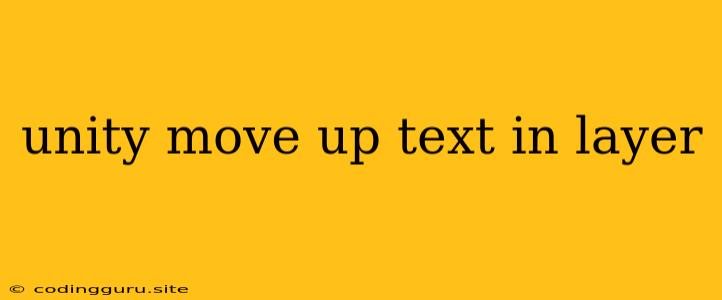Moving Text Up in Unity Layers: A Guide to Layer-Based Animation
Unity, the powerful game engine, allows you to create intricate and engaging environments. But sometimes, you might need to bring your text to life with a simple animation, like moving it upwards. This can be achieved through layers and their properties.
Why Layers?
Layers in Unity serve as a powerful tool for organizing your game objects and creating visual effects. By placing your text on a separate layer, you can easily manipulate its position and animation without affecting other objects. This is particularly useful when you want to create a dynamic and captivating user experience.
The Basics of Unity Layers
- Layer Creation: You can create new layers in the "Tag Manager" window.
- Assigning Objects to Layers: Select your text object in the Hierarchy window and assign it to a specific layer in the "Inspector" panel.
- Layer Mask: This feature allows you to control which layers are visible to certain objects or cameras. You can use this to selectively hide or show your text depending on specific game events.
Methods for Moving Text Upwards
1. Using a Script (C#)
using UnityEngine;
using UnityEngine.UI;
public class MoveTextUp : MonoBehaviour
{
public float speed = 2f; // Adjust this value for desired speed
public Text text;
void Start()
{
text = GetComponent();
}
void Update()
{
text.transform.position += new Vector3(0f, speed * Time.deltaTime, 0f);
}
}
- Attach the script to your text object: This script will move the text upwards.
- Adjust the
speedvariable: Control the rate at which the text ascends. - Modify the script for other directions: You can easily adapt the script to move the text in different directions by changing the
Vector3value.
2. Animation System
- Create an animation: In the "Animation" window, create a new animation clip.
- Add a keyframe: Select the "Transform" property in the "Inspector" and set a keyframe at the beginning of the animation.
- Move the text: Manually move the text object upwards in the Scene view.
- Add another keyframe: Create another keyframe at the desired time and position. This defines the end point of the animation.
- Play the animation: Use the "Animator" component on your text object to play the animation. You can control the animation's speed and looping behavior through the Animator component.
Layer Masking for Control
You can utilize layer masking to control when the text animation is visible. For example:
- Create a camera: Use the "Main Camera" or create a new camera object.
- Set the culling mask: In the "Inspector" of your camera, under the "Culling Mask" section, only enable the layer that contains your text.
- Trigger the animation: You can trigger the animation based on game events, such as player interaction or a specific timer.
Optimization Tips
- Keep it simple: For straightforward text animations, scripting is generally more efficient than using the Animation system.
- Optimize your code: Use the
Time.deltaTimevariable in your scripts to ensure consistent animation speed regardless of frame rate. - Limit the number of layers: While layers offer flexibility, having too many layers can impact performance.
Example Scenario
Imagine a game where you need to display a countdown timer on the screen. You can use a text object and move it upwards to create a rising countdown effect.
- Create a layer: Name the layer "TimerLayer" in the "Tag Manager".
- Assign the layer: Set the layer of the text object to "TimerLayer".
- Use a script: Create a script similar to the one provided earlier, and adjust the speed to your desired animation rate.
Conclusion
Moving text up in Unity using layers opens up a world of possibilities for creating engaging and visually appealing animations. By leveraging layers, scripts, and animation systems, you can create dynamic text effects that enhance the user experience and add depth to your game. Experiment with different techniques and find the best approach for your specific needs.
